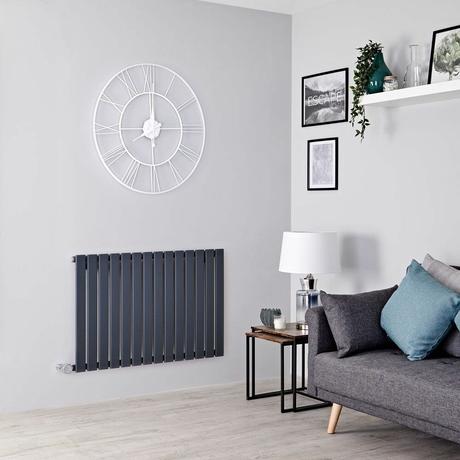If you couldn’t count on BestHeating to be passionate about best heating practices, who could you trust?!
We know that heating the home can prove one of the most expensive, yet entirely necessary ongoing strains on income. So we understand the importance of identifying the most cost-effective heating solutions for your specific space.
Of course, oil and gas have long been considered the go-to fuel source options for the radiators of UK residences. But as that statement sounds like it could have been directly lifted from a BBC period drama, you could be forgiven for craving to explore alternative modernized models.
And with technological advancements abound in the design of electric radiators, could they represent the ideal heating solution to lead you to the promised land of lower energy bills?
We’ll take a look at how electric radiators work with regards to space heating and the amount of heat they generate in this article. And ultimately, help you decide if energy efficient electric radiators are the right choice for you and your home.
Working out Electric Radiator running costs
To borrow a line from the Stone Roses, there’s no surefire set solution to work out electric radiator running costs. Though it’s hardly a ten-storey conundrum to garner a basic estimate in accordance with your typical energy usage habits.

You can group together the energy expended by electric radiators with that used by other electrical appliances, but there’s a vast difference when heating is involved.
For example, although a television set and an electric radiator both use electricity to operate, they do so in a fundamentally different fashion.
A TV will utilise energy all the while it is switched on, only stopping once you’ve finished your latest Netflix binge, or hit the standby button in a rage at James Corden’s latest “comedy”.
Meanwhile, electric heating systems will utilise an internal thermostat to switch on and off in line with the preferred set temperature for the room. They’ll only actually expend energy when they need to kick an extra amount of heat out to top up the room to a comfortable setting.
A key takeaway then, is that a 500W plasma TV won’t translate to the same cost of electricity as a 500W electric radiator would, despite their identical power outputs. In fact, you’re very likely to get more bang for your buck from electric heaters in comparison with other electrical appliances.
Other factors to influence Electric Radiator running costs
There’s plenty of other factors that can influence electric radiator running costs. In most instances, the variables pertain to which room in the house you are looking to heat electrically.
Contrasting layouts, room designs, and what the spaces are used for can all help or hinder electric energy bills.
Our BTU Calculator can help you determine what sort of radiator will work for any room, but listed below are some of the more prominent influences on electric radiator running costs.
Room Size
The height from the floor to the ceiling is especially important in calculating how much energy will be used to heat a room, regardless of the heat source.
Open plan rooms or those with extremely high ceilings always require more energy to stay warm given the nature of the way radiators conduct heat.
Hot air rises from the radiator, with heat traveling to the peak of the room before making its way around the areas that probably need it more. As such, it will take longer for the room to heat up adequately. So if you live atop of the tallest castle with the largest spire, an electric radiator might not be the best bet. (I have ‘Tangled’ on the television to keep my daughter quiet as I write this).
Room Insulation
When heating an older home, the likelihood is you’ll have to fork out more money to effectively run your heating continuously.
Modern properties have been increasingly designed with air tightness in mind, ensuring they provide better insulation levels for improved energy efficiency. The reduction in heat loss for newer properties means that electric radiators, or any other type of designer radiators, will be cheaper to run in them. While older homes, with single glazing and poorer general insulation, will have to run radiators for longer, and at a higher temperature, to achieve a comfortable level of warmth.
When heating an older home, the likelihood is you’ll have to fork out more money to effectively run your heating continuously.
House location
A less obvious point to consider regarding the efficiency of electric radiators is the location of your property. Basically, how exposed the house is to the elements is the deciding factor.
For instance, a terraced property can benefit from the residual heat provided by the immediately surrounding homes on either side. By contrast, detached homes are open from all angles, which makes it tougher to keep them properly heated.
It’s actually a simple equation. The more exposed your house is to more turbulent conditions, the more energy it will take to heat to a comfortable temperature.
So if you’re well above sea level in a north facing property, your electric radiator running costs are simply bound to be higher than in other circumstances.
How do you like your heating?
And ultimately, personal heating preferences can strongly influence the running costs of electric radiators, or any type of heating system for that matter.
For instance, if you’re constantly feeling cool and need your room temperature around 22 degrees or more to feel comfortable, your heating costs are sure to be higher than if you like to chill at about 15 degrees.
You should never sacrifice your comfort to save a few quid though.
Remember too, that the trends and patterns of your daily routine could see your energy bills fluctuate. Your working hours, daily habits and seasonal weather shifts will all lead to heating cost differentials.
How to calculate Electric Radiator running costs
There’s a relatively simple means to calculate electric radiator running costs. But you should be wary that it is only a basic equation that doesn’t account for any of the variables at play detailed earlier in this article.
You can gain a basic idea of electric radiator running costs using the following formula…
Radiator output (kW) x hours of usage x pence per kW hour = daily radiator running cost (p)
As an example, for a room with an 800W electric radiator that will be in use 6 hours per day, just multiply 0.8kW by 6 to result in 4.8 kW/h. Then, the electric tariff comes into play. Say you are charged at 16p per kW hour, you need to multiply 4.8 with 16, equaling an average daily cost of 76.8p to run your electric radiator each day.

Good news though – it’s almost certain to be less than that, as the calculation doesn’t factor in the use of the in-built thermostatic control, and that it will usually turn on and off in accordance with the air temperature. So the radiator won’t be on at full power the entire time.
The amount of usage hours is definitely the biggest cause for fluctuation in radiator running costs. You’re bound to incur bigger heating costs on a lazy hungover Sunday lounging about the house than you would when you’re down the pub on a Saturday creating said hangover, for example.
Plus, if you have a well-insulated home, it will retain heat well, only requiring your radiator to switch on at sporadic intervals to crank up the heat.
Say your electric radiator was only actually expending energy a quarter of the time mentioned in the example above, and your running costs would only actually equate to 19.2p per day.
Or, if you have an older property that isn’t quite as well insulated, the radiator might still only be required about half the time – at a cost of 38.4p each day.
When putting together your estimations, be sure to take into account your lifestyle habits over the weekend, as well as work patterns, and how you’ll use your heating in the warmer and colder months of the year.
Get in touch with BestHeating
So there you have it. You should have a decent idea regarding the running costs of electric radiators! But, as ever, if you want to know more about whether an electric radiator investment is worth it, or have any other home heating questions, don’t hesitate to get in touch with us.
You can leave your queries or thoughts in the comments section below, or contact us via Instagram, Facebook or Twitter.


